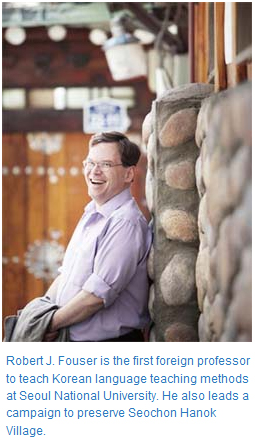|
Robert J. Fouser, Hanok village keeper

One of his favorite foods is bibimbap, a bowl of steamed rice mixed with
a variety of namul (greens) and red gochujang (red pepper paste). His
eyes were glued to the TV when he watched the made-for-television period
drama The Deep-Rooted Tree, which deals with how Sejong the Great (the
fourth king of the Joseon Dynasty) created the Korean writing system
called Hangeul. His evenings are often spent chatting about this and
that with neighbors over makgeolli.
This is the life of an average Korean middleaged man today, and also the
life of Robert J. Fouser (51), a native of Michigan. In 2008, he became
the first foreign professor of the Department of Korean Language
Education at Seoul National University to instruct undergraduates and
graduates in methods of teaching Korean.
“What is wonderful about Hangeul is that it’s extremely easy to learn,”
says Fouser. “It’s a bit difficult to combine the letters, but the
letters themselves are really a piece of cake. If you know the
consonants and vowels, there are no words you cannot read even if you
have no idea what they mean. I mastered Hangeul in three days, but
learning Chinese characters or the Japanese writing system takes a long
time.”
Mesmerized by Seochon Hanok Village
What brought him deep into the heart of Korea? He earned his bachelor’s
degree in Japanese language and literature from the University of
Michigan (1983) and lived in Japan for about a decade (1995-2006). In
between, he studied Korean intensively at Seoul National University for a
year (1983-1984). Some years later, he found himself teaching English
at Korean colleges, and some years after that, teaching Korean in
Japanese at Japanese colleges (2006-2008). He finally came back to Korea
to settle in 2008.
Fouser is equally as intrigued by Hanok as he is by Hangeul. He founded
the Seochon Neighborhood Society a year ago to launch a campaign to
preserve the Hanok village.
Seochon (lit. Western Village) is a neighborhood west of Gyeongbokgung,
the main palace of the Joseon Dynasty (1392-1910), composed of over ten
smaller neighborhoods clustered together. It may seem somewhat
surprising that a foreigner should be at the vanguard of the movement to
preserve Seochon, which retains in its ambience the memories and
history of the Joseon Dynasty.
When your reporter for KOREA asks him why he is so interested in Seochon, his eyes light up with passion.
“The older you get, the more you yearn to communicate with old memories
and the past,” says Fouser. “I like Seochon since it is still as I saw
it in the 1980s, when I came to Seoul for the first time. Old signs,
narrow alleys, detached houses with gardens, and all those things make
me feel the Koreans’ warm and generous affection for fellow human beings
known as jeong.”
In recent years Seochon was threatened by reckless development. Fouser’s
heart broke at the thought of old Seochon being bulldozed to the ground
ostensibly in the name of redevelopment and progress. This prompted him
to roll up his sleeves to keep Seochon intact. He could not just sit
idly by and watch the charms of the past be destroyed. The Seochon
Neighborhood Society mainly comprises residents of Seochon. They hold
biweekly meetings to collect information on their village and discuss
ways to preserve it.
This June marks the first anniversary of the founding of the society.
Its members plan to publish a historical map of Seochon and explore
every corner of the neighborhood. They will also get the society
registered as a nongovernmental organization (NGO). Fortunately, Seoul
City has instituted protections for some Hanok districts.
The magic of the Hanok madang
Robert J. Fouser lives in a Hanok, not in Seochon but in the Bukchon
Hanok Village, a neighborhood between the two palaces of Gyeongbokgung
and Changdeokgung. He had lived in Seochon for one year, but left three
years ago due to his disappointment with the myopic development of the
area in a craze to make money through real estate. Bukchon has been
subject to more rigorous zoning regulation than Seochon, so its Hanoks
are better preserved.
His Hanok has three rooms and a courtyard of a sort in the middle called
a madang. A Hanok in the Seoul area is usually in a ㄷ-shape or ㅁ-shape,
and the enclosed space is a madang. Not found in Western houses, the
madang in the middle is a third space that has seemingly magical
qualities about it. In a Western house, indoor and outdoor spaces are
clearly divided, but a madang can be both an indoor and outdoor area.
This affords great convenience in many respects. He uses his madang to
grow trees and greens and keep a dog.
“I used to live with another person in the same house with the madang
between us,” recalls Fouser. “Since a madang is a shared space and
divides the house into two independent spaces, we lived together
comfortably. When my foreign friends come to Korea, I invite them to
stay at my place, and they love it.”
Saying he knows every nook and cranny of Seochon like the back of his
palm, he guides your reporter here and there through the neighborhood,
pointing out its quaint charms. He sometimes stops in front of a house
and boasts that friends live there. When he says he is moving back to
Seochon later this year, his face beams with a broad smile.
*Article from Korea Magazine (June 2012) |
|
|
|
|
|
|
|
|
|
|
|

|

